By Molly Kirk/DWR
Photos by Meghan Marchetti/DWR
The Virginia Department of Wildlife Resources (DWR) is pleased to announce the winners of its third annual Restore the Wild Artwork Competition. A panel of judges chose winners in the Natural History Illustration, Artistic Expression, and Youth categories as well as artwork to be used throughout 2023 to help promote Restore the Wild’s mission. This year, the Restore the Wild committee asked artists to portray the eastern hellbender, North America’s largest salamander, as the 2023 Restore the Wild species of focus, to help draw attention to how clean water is essential for the hellbender and so many other aquatic species.
“This was a banner year for the Restore the Wild Art Competition—it exceeded our expectations in every way,” said Restore the Wild committee member and DWR Watchable Wildlife Biologist Jessica Ruthenberg. “Not only were we blown away to receive 139 submissions—by far a record for this competition—but we were also thrilled by the tremendous quality of the artwork and the wide variety of artistic styles and mediums used to interpret the eastern hellbender. We are humbled that so many talented and creative people took the time to enter this contest. And, thanks to a new and exciting partnership with Artspace, this is the first year that we’ve been able to exhibit the contest submissions for public display. Our committee wasn’t sure what to expect for the opening night of a hellbender art show, but the turnout and enthusiasm at the gallery was absolutely overwhelming. Clearly, there is a lot of love out there for the eastern hellbender!” All 139 contest entries are displayed in the Elisabeth Flynn-Chapman Gallery at Artspace in Richmond through Friday, March 17.
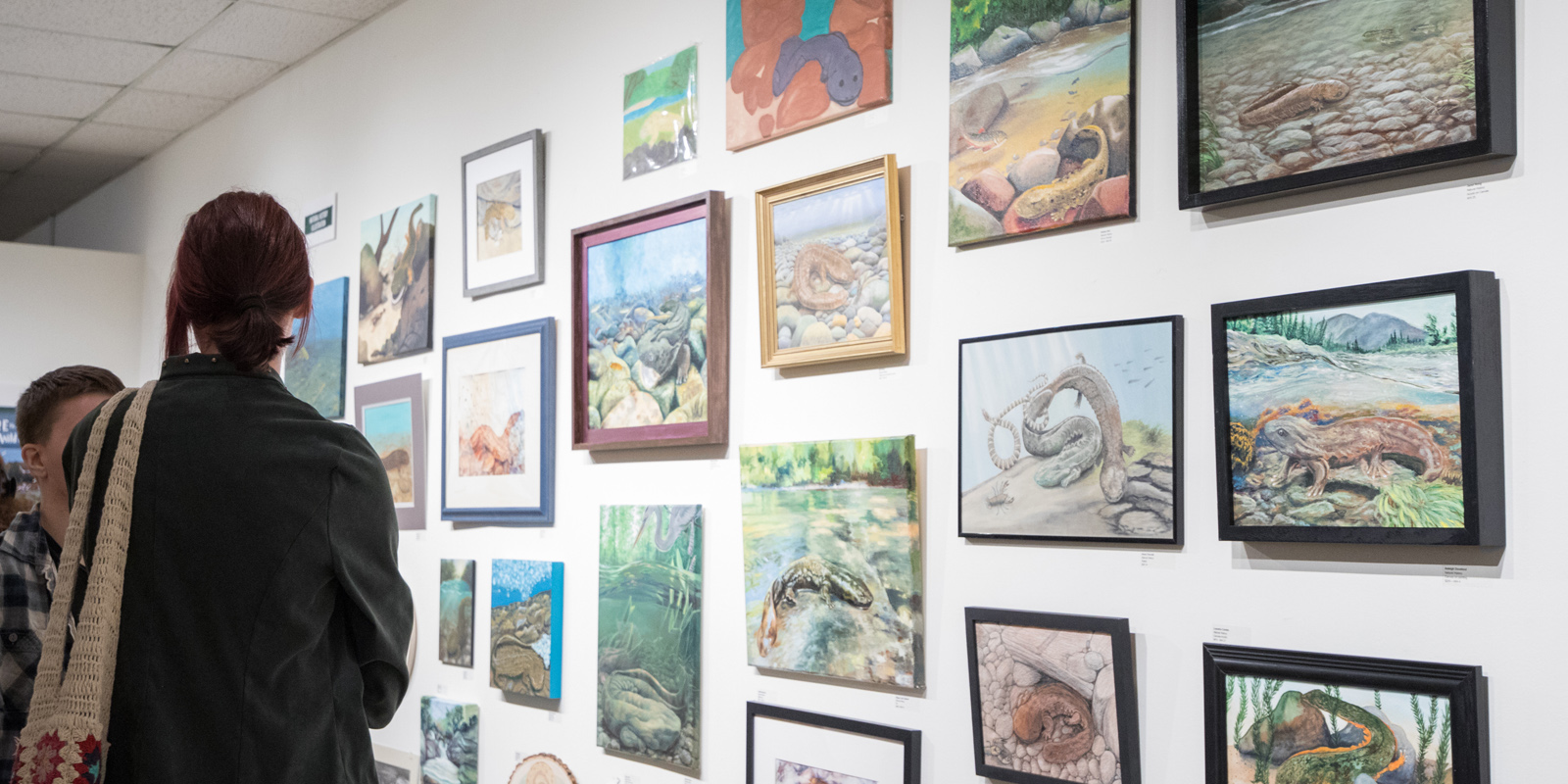
All entries to the 2023 Restore the Wild Artwork Competition were displayed at an exhibit at Artspace in Richmond.
Each year, the contest calls for submissions from the public that reflect Restore the Wild’s mission to restore and create natural habitats vital to the survival of Virginia’s wildlife. This year, we were seeking a celebration of that mission with a focus on the eastern hellbender and clean water as the subjects.
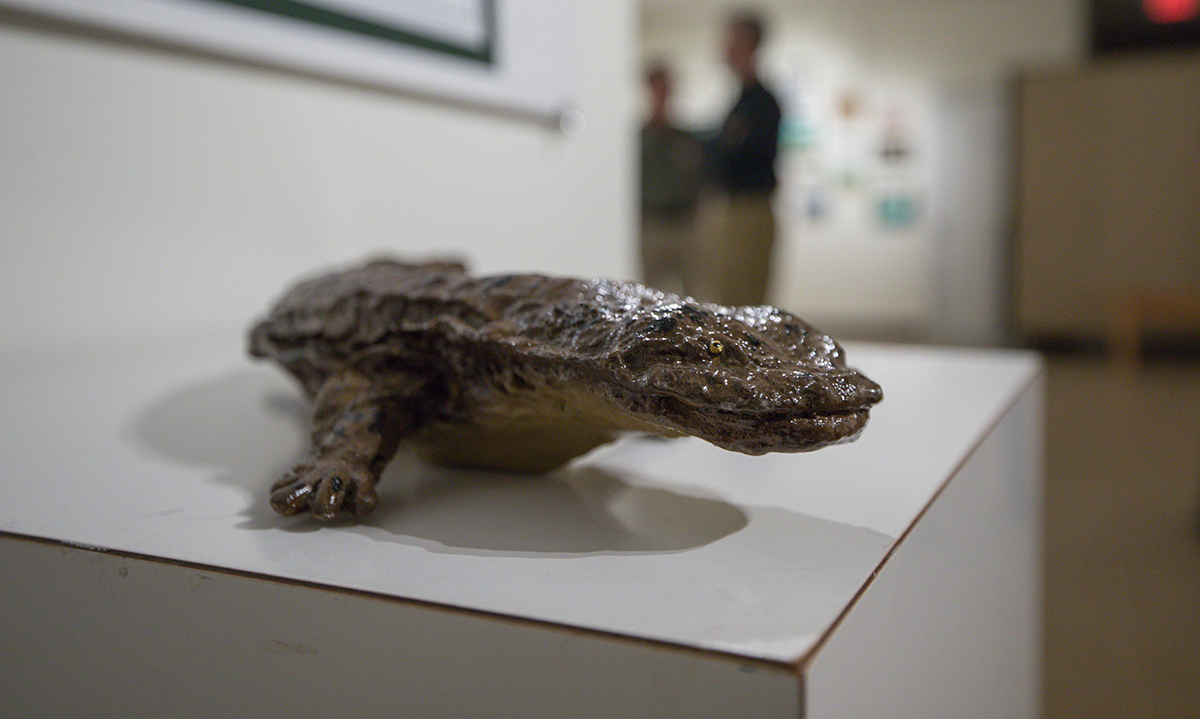
A life-size model of an eastern hellbender greeted visitors to the Restore the Wild Artwork Competition exhibit.
Jared Sells’ depiction of a hellbender, titled “New River Water Dog” topped the Natural History Illustration category, which asked artists to create realistic scenes depicting the species in its natural habitat. “It is a blessing and an honor for my artwork to be chosen from among so many great artists as the winner of a category. It’s also an honor to heighten awareness about their decline, so people will be more aware of them and their habitat,” said Sells, of Laurel Springs, North Carolina. “I am originally from Southwest Virginia, and I remember when I was growing up hearing from local fisherman about the eastern hellbenders, or ‘water dogs’ as they are called in that area. I remembered the stories I heard about the areas that they were found in, and I tried to recreate that in my painting. I didn’t realize they were in decline and endangered in areas. [In the process of researching the painting,] I also learned they are the biggest salamanders in North America.”
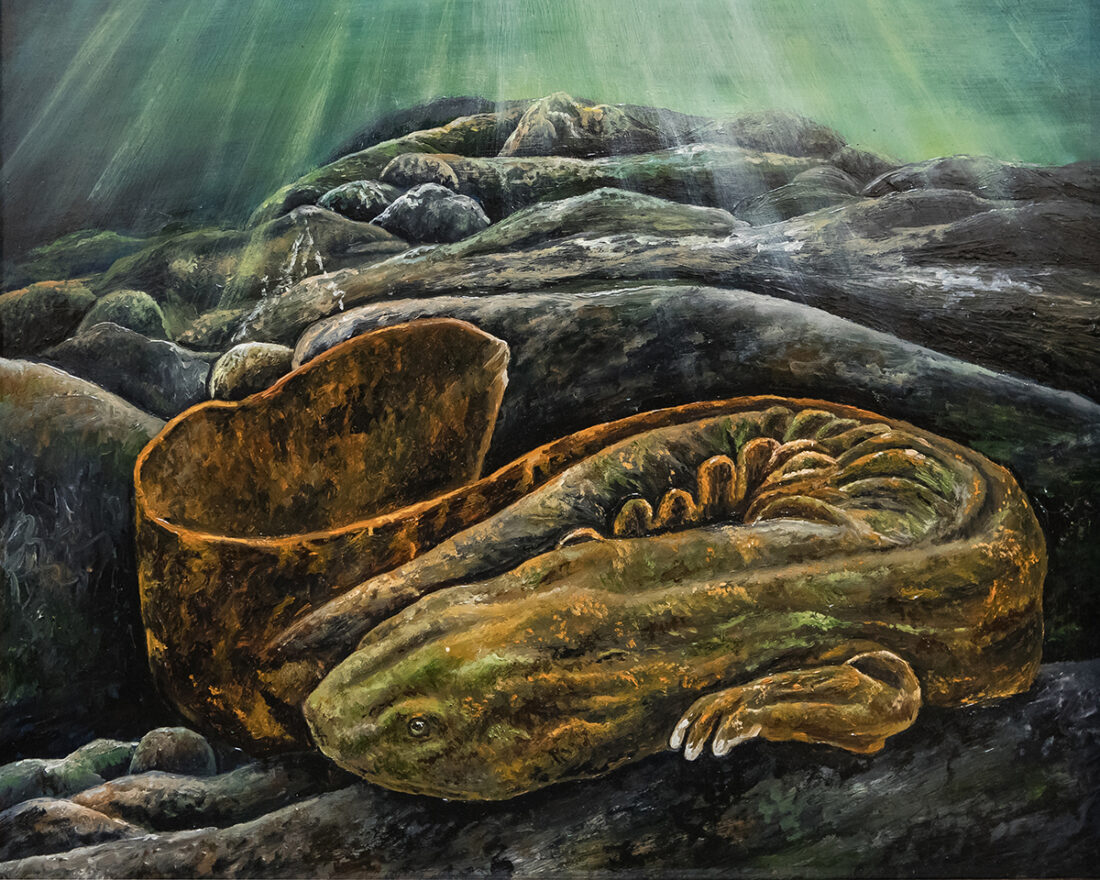
Jared Sells’ oil painting, “New River Water Dog,” won the Natural History Illustration category.
The Artistic Expression category asked artists for their creative interpretation of the eastern hellbender and their habitat. Sasha Peterson topped this category with her work, “Cryptobranchus.” “Winning the artistic expression category is very exciting for me. It definitely encourages me to do more art pieces inspired by nature and to express myself creatively in a very different way than I normally do in my career as an architect. I am also so happy to be able to help increase awareness for the eastern hellbender and participate in a small way toward conserving the creatures and environments that enrich my life,” said Peterson, of Arlington, Virginia. “The more I read about them, the more I realized that the hellbenders are inseparable from their habitat, requiring very clean, fast-moving water. This inspired me to do a more conceptual piece in watercolor that expressed the salamander and its stream bed home as one.”
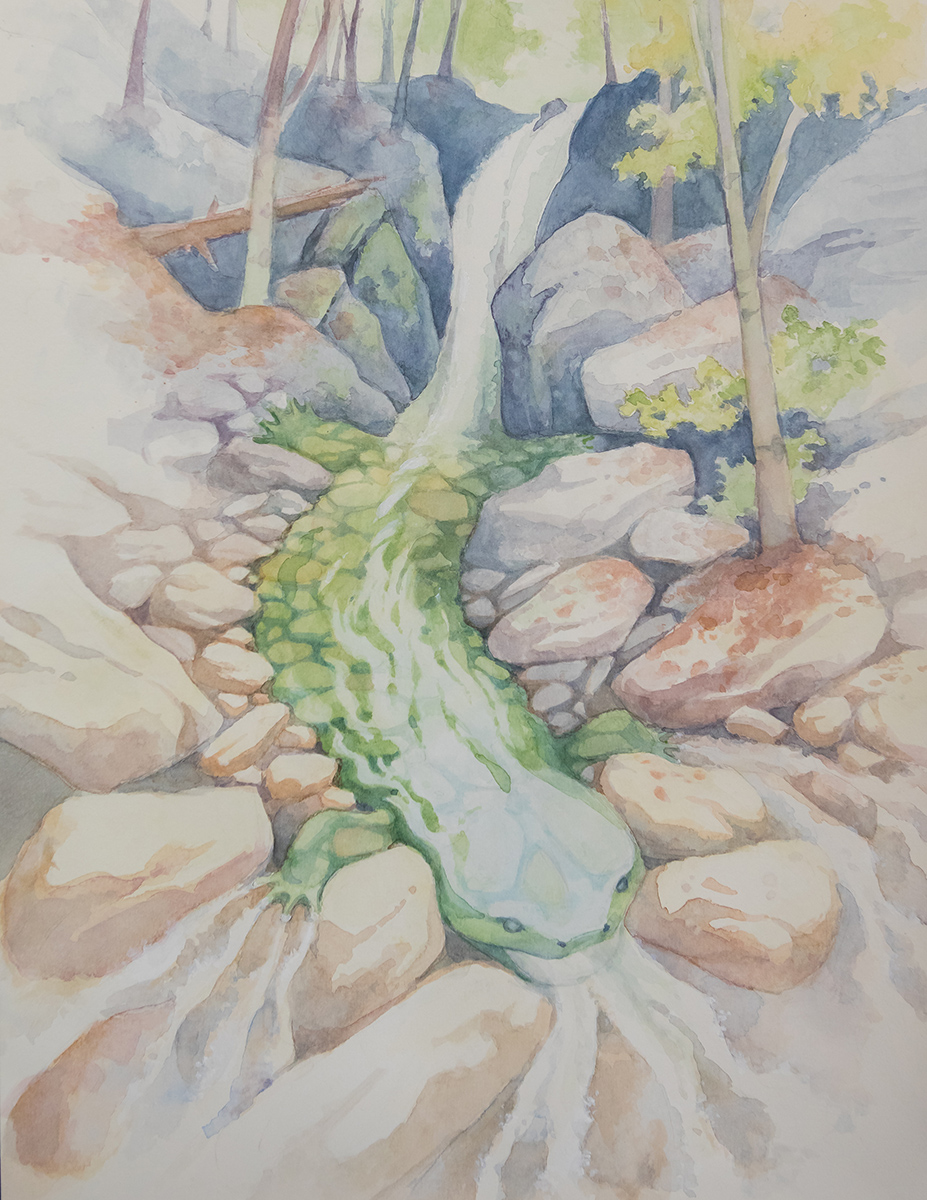
Sasha Peterson’s watercolor painting, “Cryptobranchus,” was selected by the judging panel as the Artistic Expression category winner.
Lily Perry, age 14, won the Youth category with her piece “Rock Bottom.” “Living in rural Virginia, I am always surrounded by the beautiful natural world. It isn’t uncommon to find me outside running, swimming, and overall enjoying the sun. If I am able to help an interesting natural animal with my artwork, then I am happy to do so,” said Perry, from Arrington, Virginia. “I really enjoy painting aquatic animals and their environments. I have always thought of hellbenders as only being a mud brown color. As I dove deeper into my painting, I realized the beautiful undertones of red, orange, yellow, and green their skin expresses.”
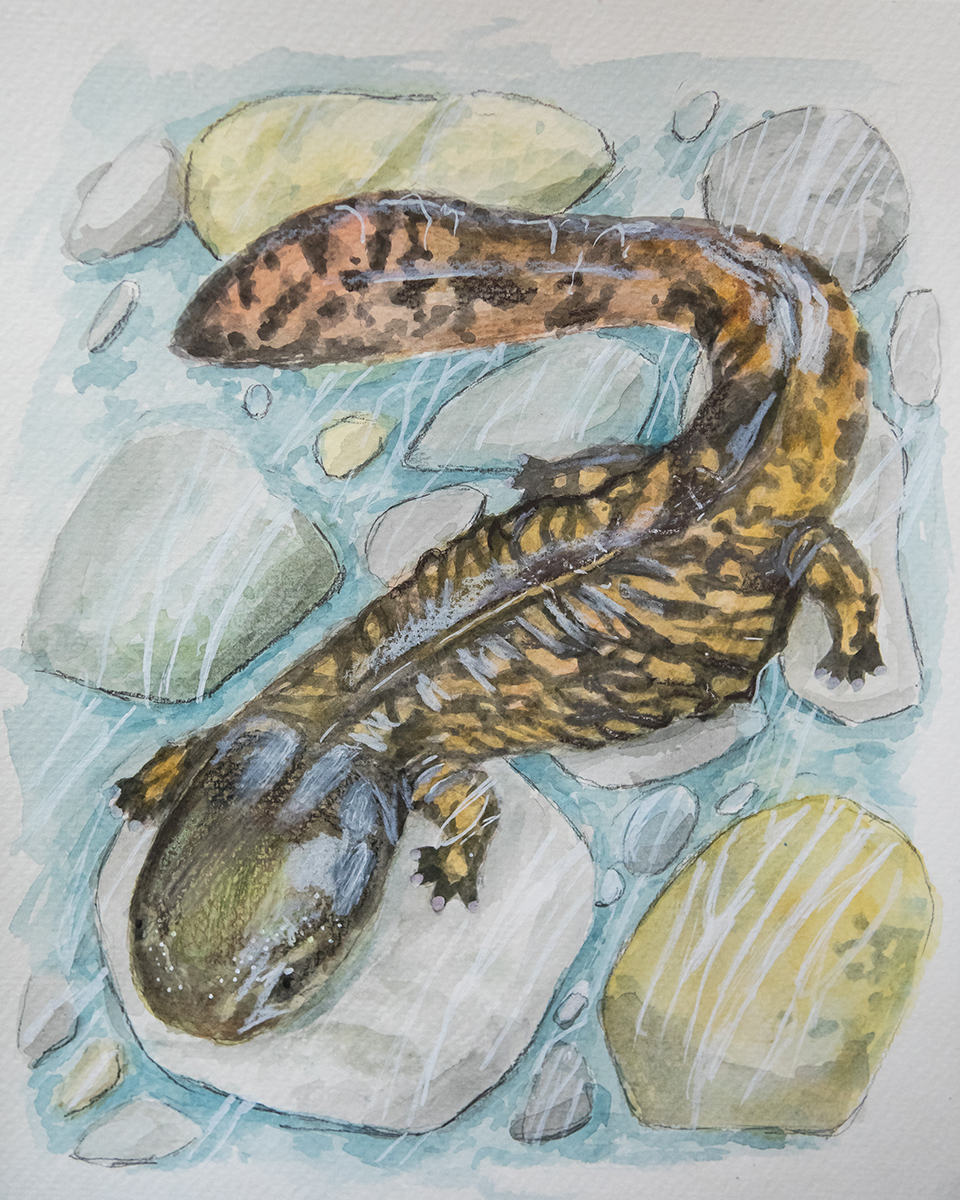
Lily Perry won the Youth category with her “Rock Bottom.”
The judges chose Virginia Greene’s work “Please Don’t Roll My Rocks” to be reproduced in a commemorative Restore the Wild sticker given to all Restore the Wild members. “When I learned that the topic was the hellbender, I knew I had to participate,” said Greene, who lives in Staunton, Virginia, and works as a Restoration Specialist with the Virginia Department of Conservation and Recreation (DCR) Virginia Natural Heritage. “My early childhood was spent looking for frogs and salamanders, and I’ve been visiting the Appalachian region of Virginia my whole life. Hellbenders in particular underscore the uniqueness of the Appalachian ecosystem. I wanted to paint something light-hearted that captured their Appalachian spirit—and so I gave my subject a little banjo. I added trout fry and crayfish to show a little piece of this incredible ecosystem that depends on clean water. A world without rich, vibrant natural communities is a world I don’t want to imagine. And so, I am honored to win one of the categories, because it means my artwork will help support conservation and management of Virginia wildlife—and that’s about the best thing I can imagine it doing.”
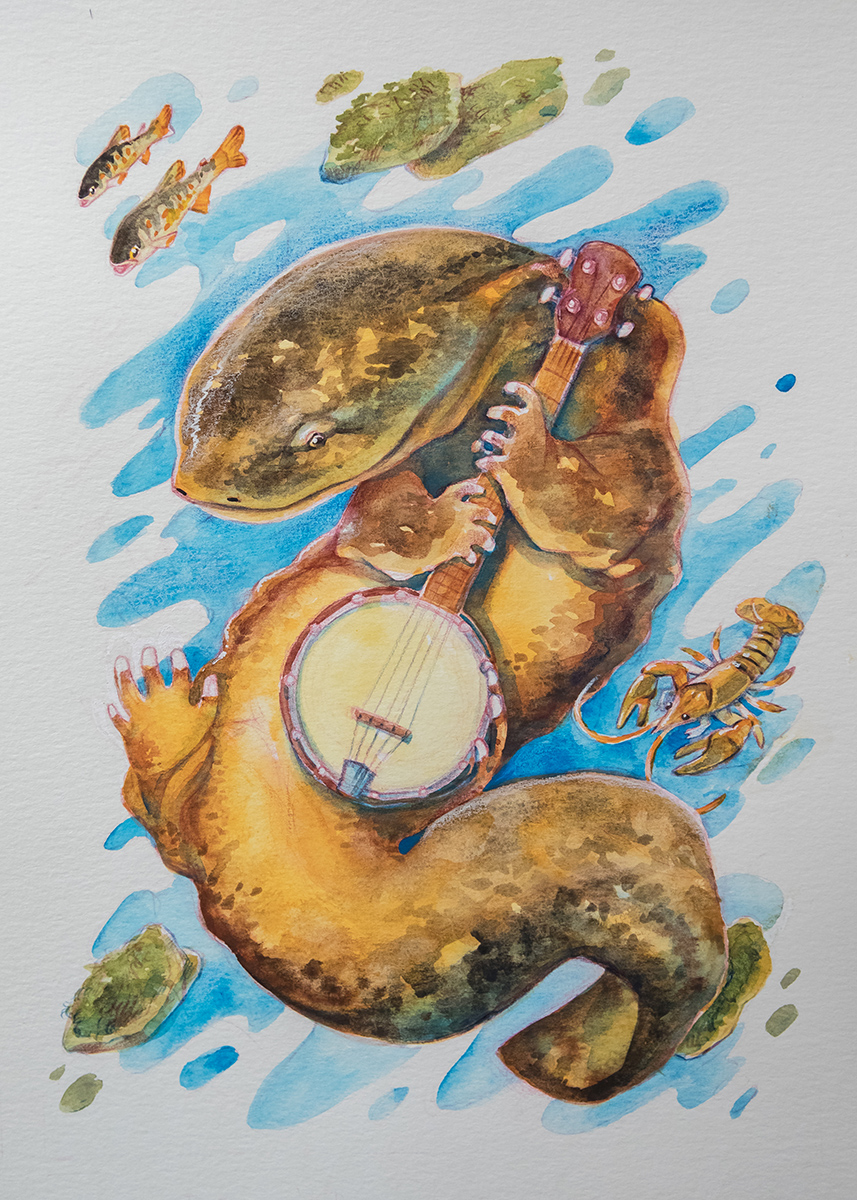
The judges chose “Please Don’t Roll My Rocks,” a watercolor by Virginia Greene, to be reproduced for the 2023 Restore the Wild sticker.
Sandy James of Gordonsville, Virginia, created “Hellbender,” the piece the judges picked to be reproduced as a print representing Restore the Wild’s focus species of 2023. This print will be given as a gift to Restore the Wild’s Golden Eagle members, the highest tier of membership. “I am beyond honored to have my work win a category in the Restore the Wild Artwork Competition,” said James, who enjoys fishing, hiking, and camping, and is rarely without a camera in her hand.
“I feel the eastern hellbender is an amazing and misunderstood creation, and I hope my artwork can help call attention to its importance within its delicate ecosystem,” James continued. “The more I learn about the eastern hellbender, the more I am impressed with its body structure and living arrangements. Its flexible skin serves as a breathing apparatus, as well as an underwater propulsion system. Its tiny eyes, wide mouth and human-like ‘hands’ and feet all merit a second look. And the fact that the males protect and nurture the eggs and young is yet another reason to want to know more about this beautiful clean-water denizen.”
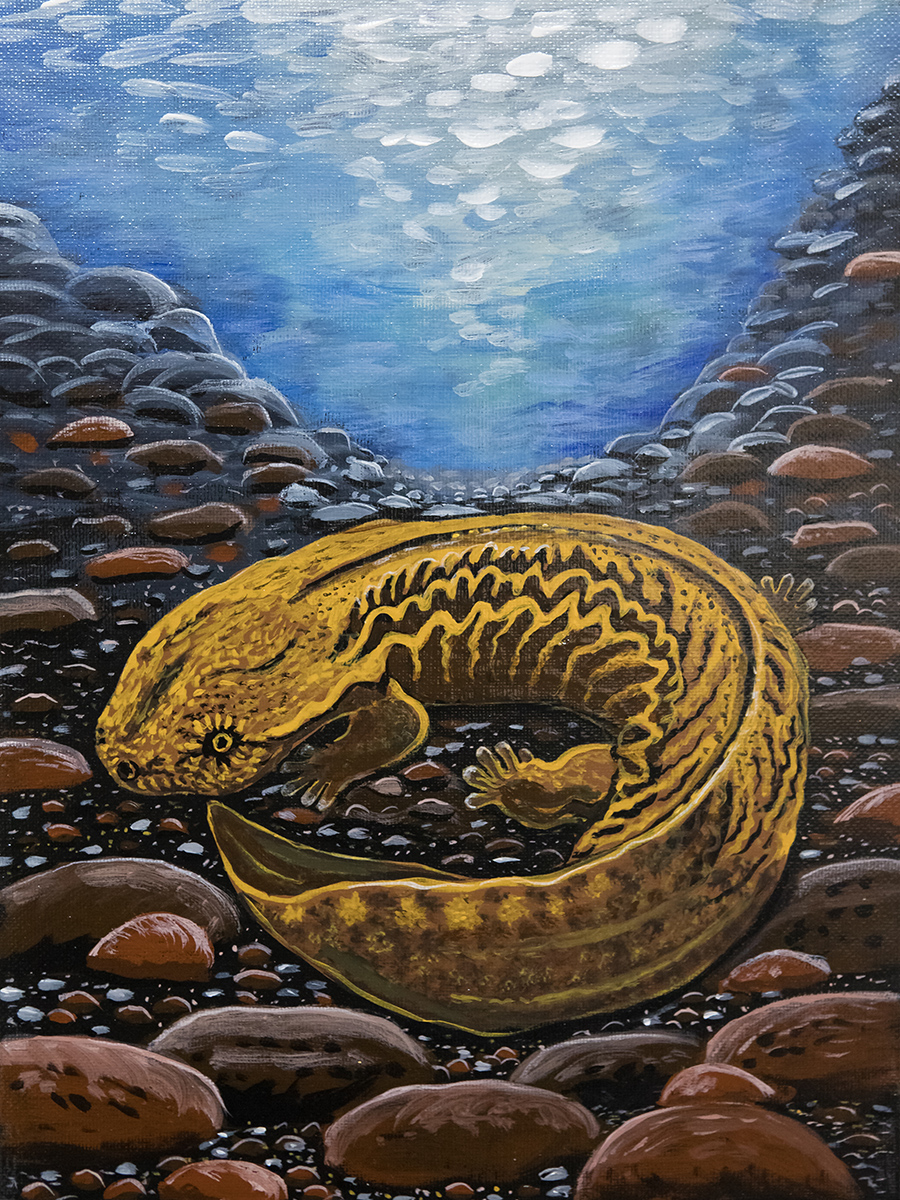
Sandy James’ “Hellbender” was chosen to be reproduced as an art print for Restore the Wild members.
The subject focus of 2023’s artwork was the eastern hellbender, an aquatic salamander that has been identified as a Tier 1 Species of Greatest Conservation Need in the Virginia Wildlife Action Plan. Eastern hellbenders are an aquatic species that prefer clear, fast-flowing, well-oxygenated streams and rivers in southwest Virginia. Because of hellbenders’ preference for clean streams and rivers, their presence serves as an excellent indicator of good water quality. The declines of eastern hellbender populations can largely be attributed to the degradation of stream quality, which is caused by the damming of rivers, water pollution, and siltation of streams.
Virginia has more than 900 species of wildlife whose numbers are in decline mostly because of impacts to their habitat—natural areas that provide necessary food, water, and shelter. DWR is the lead agency in Virginia for the conservation of wildlife and wildlife habitat. DWR’s Restore the Wild initiative allows DWR to expand the work the agency does to preserve, establish, and maintain vital wildlife habitat areas and keep Virginia’s wild places wild. Memberships and donations to Restore the Wild provide funds directly for DWR habitat projects that benefit Virginia Species of Greatest Conservation Need.
The first three years of Restore the Wild raised more than $100,000 in membership funds and donations. The funds were used immediately to support 14 DWR habitat projects throughout the state, directly benefiting a diversity of imperiled wildlife. The initiative has funded more than 250 acres of habitat restoration in Virginia. The winning Artwork Competition pieces will be used to help promote Restore the Wild’s mission throughout 2023.
Find out more about DWR’s Restore the Wild initiative and consider becoming a member or making a donation to help restore and maintain essential habitat for Virginia’s wildlife.



